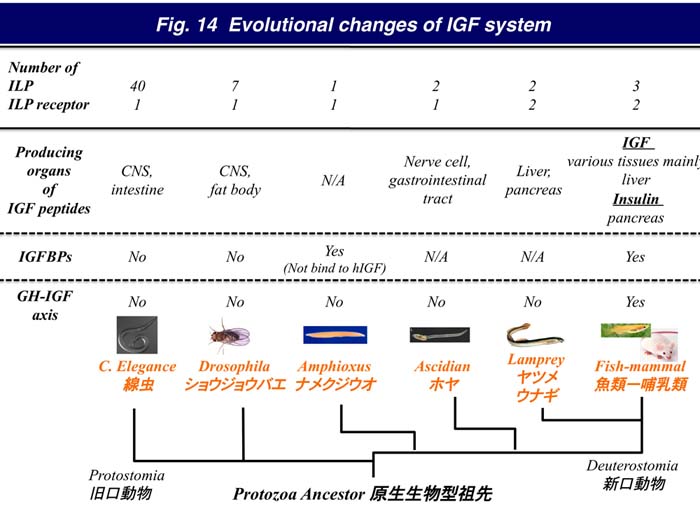IGFs are shown to play important roles in development, growth and maturation. In addition, IGFs are important for homeostasis of protein metabolism. Insulin is well known to be required for control of glucose and lipid metabolism. Why do these factors need to function differently even though their structure is very similar and they share the same signaling pathways? Based on the existence of hormones and receptors in various models, their function may be separated recently from the evolutionary point of view, since these hormones diverged after Ascidian appearance and both insulin receptor and IGF-I receptor are appeared after the lamprey emerged (Fig. 14). In addition, in fish and chicken insulin secretion is mainly regulated by amino acids not by glucose, suggesting insulin secretion is controlled by rapid changes in amino acid levels (food intake) and IGF responded to chronic changes of amino acids levels when the cell numbers in one animal become huge.
Why are many insulin-like peptides produced in Protostomia and only few peptides produced in Deuterostomia? In C. elegans and Drosophila insulin-like peptides are secreted from the central nervous system and each peptide monitors different environmental changes. These information source converge onto the one receptor and subsequent signaling pathway. However, in fish and mammals, insulin-like peptides are produced in various peripheral tissues and their synthesis and levels are regulated by various factors such as central nervous system or IGF binding proteins which can respond to environmental changes. We supposed that 2-3 peptides would suffice because of the conversion of environmental into the IGF and insulin synthesis and secretion by other factors that can monitor the environmental changes.
Recently, repression of insulin-like signals was shown to be important for longevity in C. elegans, Drosophila, and mice. In contrast, high insulin-like signaling increases the risk of malignancy. However, it is well known that repression of insulin signaling causes insulin resistance leading to type II diabetes and repression of IGF signaling results in a dwarf phenotype of shortened life span. Taken together with other data, these results demonstrate that GH, IGFs and insulin are anti-aging hormones but controlled insulin-like activity is essential for longevity.
